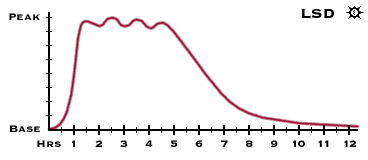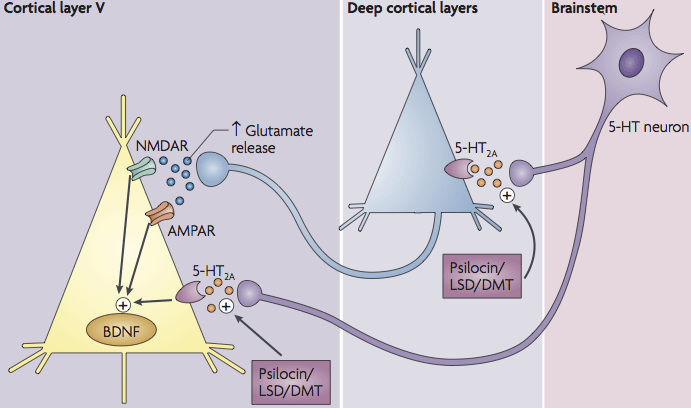How LSD works for therapy
How LSD works for therapy (bron: Triptherapie)
LSD is the strongest psychedelic
LSD (Lysergic acid diethylamide) is considered one of the most powerful psychedelics because of its potency, duration and effects. Some more experienced psychonauts choose for LSD therapy because it’s the strongest psychedelic. Here are some reasons why LSD is considered the strongest known psychedelic:
- Potency: LSD is highly potent and can produce very powerful effects at doses of only a few micrograms (µg). For example, a typical dose of LSD is about 100-200 µg, while the effects of psilocybin are usually felt at doses of 10-30 mg and DMT at doses of 10-60 mg. This means that LSD is about 500 times more potent than psilocybin and DMT.
- Trip duration: LSD trips can last up to 12 hours while psilocybin and DMT usually have a shorter duration. This long effect can make the experience of LSD deeper and more intense than that of other psychedelics.
- Effects: LSD is known for its ability to produce very intense and complex visual, mental and emotional effects. These effects can vary greatly from person to person. The most common effects include changes in perception, heightened introspection, mystical experiences and strong emotional reactions. These intense effects make LSD a unique and potentially overwhelming experience.
The reason why LSD has a strong effect and long duration is that LSD fits into the same receptors as DMT and psilocybin but does not come out easily due to the shape of the molecule. Furthermore, the liver can break down LSD in and slow way and these breakdown products are excreted through the urine. This is different from DMT and psilocybin.

LSD acts on receptors in the brain
The effect produced is mainly related to the serotonergic receptors. These 5-HT receptors are distributed in the brain and the binding of LSD on these receptors changes the excitatory conductance in the brain. LSD has affinity for these receptors:
- 5-HT2A receptor: LSD binds primarily to this receptor, which is involved in regulating perception, cognition, emotion and consciousness. Stimulation of this receptor by LSD can lead to changes in visual perception, intensification of emotions and changes in consciousness. It can also increase activity in the prefrontal cortex, which can lead to changes in thinking and a sense of connection with the environment.
- 5-HT1A receptor: LSD can also bind to this receptor, which is involved in regulating anxiety, depression and mood. Stimulation of this receptor may lead to reductions in anxiety and depression, although it is not clear to what extent LSD stimulates this receptor.
- Other 5-HT receptors: LSD can also stimulate the 5-HT1D, 5-HT5A and 5-HT6 receptors. Although the exact effects of this stimulation are not yet fully understood, it may be related to the anxiolytic and antidepressant effects of LSD.
Increased glutamate and BDNF due to LSD
Beyond the effects a person may perceive, the chemical messengers in the brain change during the use of psychedelics such as LSD, DMT or psilocybin. Increased stimulation on 5-HT2a receptor releases more glutamate and BDNF.
Glutamate
Glutamate is the most important excitatory neurotransmitter in the brain and plays a crucial role in communication between nerve cells. When more glutamate is released, it can lead to increased synaptic plasticity and the formation of new synapses between nerve cells. This, in turn, can lead to improved cognitive functions, such as learning, memory and information processing. However, glutamate deficiency is rare and usually measured only in neurological or psychiatric disorders.
BDNF
BDNF is a neurotrophin that promotes the growth and survival of nerve cells. It is often considered an important factor in neuroplasticity and can help strengthen synapses between nerve cells. When more BDNF is released in the brain, it can lead to improved cognitive functions and the brain’s ability to process and learn new information. BDNF is also associated with protecting neurons from degeneration and promoting neurogenesis, or the growth of new nerve cells.

All in all, the release of glutamate and BDNF in the brain may lead to improved cognitive functions and the brain’s ability to adapt to new environments and situations. This may be beneficial, for example, in the treatment of conditions such as depression, where reduced synaptic plasticity and BDNF levels have been observed.
The image to the right shows the mechanism by which psychedelics affect neurochemistry and neurotransmission. BDNF plays a significant role in treating depression especially in men, but also in women. More BDNF and glutamate could theoretically provide symptom relief in some neurodegenerative disorders such as MS and Parkinson’s.
More info: BDNF and MS
The LSD experience
The experience a person has on LSD depends on the person using it, the circumstances and most importantly the dosage. Indeed, a very low dose of LSD will give little to no change, while a dose of 200 micrograms can give a full trip. The higher the dosage the more the effects will be and thus the triplevel.
More information: Psychedelics and triplevels
Het originele bericht komt van de onderstaande link
Bezoek ook onze partnersites zoals Truffel sessie, lsd therapie, truffel ceremonie, LVL 5 en , psiloflora.
Triptherapie